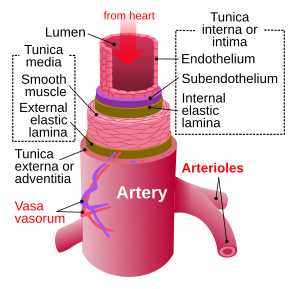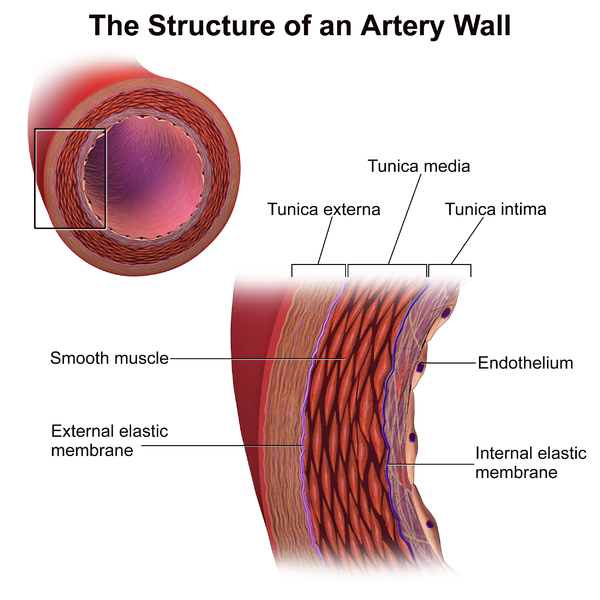Introduction
Arteries make up a major part of the circulatory system, with the veins and heart being the other main components. Arteries make up tubelike structures responsible for transporting fluid (i.e., blood for the circulatory system and lymph for the lymphatic system) to and from every organ in the body. Mainly, arteries manage the transportation of oxygen, nutrients, and hormones through our bodies. Arteries can dispense fresh oxygen to the body after it gets loaded onto the Fe 2+ found in the center of hemoglobin. The oxygen binds to hemoglobin and is carried by the arteries to areas that lack oxygen. Through a shift in affinity for the oxygen, it is then unloaded to specific areas through high surface areas knowns as capillaries.[1] Far from being a changeless structure, arteries adapt through signals received from the central nervous system, as they also react to an outer stimulus like pressure, temperature, and substances. Vascular nerves are responsible for innervating the arteries allowing them to change to their stimuli. As catecholamines get released into the blood, the nerves send signals to the arteries to either constrict or dilate, leading to changes in pressure.[2]
Arteries are composed of smooth muscle allowing constriction and dilation through the parasympathetic nervous system.[3] Arteries differ from veins in that they most often carry oxygenated blood away from the heart and into the rest of the body system. However, this is not always the case, as the pulmonary artery moves unoxygenated blood from the heart to the lungs to complete the gas exchange in the alveoli.[4] Additionally, arteries play an important role in maintaining proper blood flow to the uterus during pregnancy, allowing proper fetal growth. Arteries play a crucial role in maintaining homeostasis in the body. Additionally, arteries begin to clog with a thicking of plaque known as atherosclerosis.[5]
As individuals age, health issues begin presenting themselves in the form of stiffening or thickening of the arteries. This issue may develop due to a variety of issues ranging from advanced age, poor diet, sedentary lifestyle, and/or genetic factors such as hypercholestreriamiaAs problems arise in the structure of the arteries; it begins leading to more strain on the heart, which develops congestive heart failure and which is often fatal. More commonly, arteries continue to develop plaque which eventually leads to an obstruction of blood flow to vital organs, including the heart. Coronary arteries are crucial to providing the heart with its own blood supply; however, these arteries, such as the rest, are prone to atherosclerosis in untreated high-risk individuals. Depending on where the obstruction occurs in the coronary arteries, blood flow to a particular section or sometimes the entire heart is arrested. Ischemia to cardiac muscles may be seen as ST elevations on EKG monitoring strips as well as a rise in troponin, a significant marker of cardiac injury. If the ischemia persists, the individual may experience myocardial infection, otherwise known as a heart attack. The arteries are vital to maintaining a healthy cardiovascular system, thus, a healthy lifestyle.
Structure and Function
The arteries throughout the body are composed of three different layers. The first innermost layer of the artery is known as the intima, which is made up of a smooth muscle layer that contains one layer of endothelial cells, and the rest is smooth muscle and elastin. The tunica intima creates a tube for the oxygen-rich blood to move through to reach the appropriate perfusion site. In this way, there is no leakage from the artery, and the nutrient-rich blood can move to the appropriate area before it unloads its oxygen and other nutrients. The second layer is known as the media or the middle layer. This media layer is made up of more smooth muscle that can dilate or constrict, which adjusts the pressures felt on the arterial walls during systolic pumping. As the muscle contracts, the walls will feel more pressure from the left ventricle, and similarly, as the vessels dilate, the pressure observed will drop.[6] The last layer is the outermost, known as the adventitia.
The adventitia is crucial for connecting the arteries to other tissues in the body, including the vascular nerves, which control the smooth muscles in the arteries. In this way, the arteries do not move freely throughout the body but instead are held in place to ensure a consistent and effective cardiovascular system. Usually, the arteries are under the most pressure as they receive blood from the left ventricle, the most powerful section of the heart. However, the pulmonary artery is different for two reasons. Not only does it move unoxygenated blood from the heart to the lungs, but it also handles much less pressure, as the right ventricle has less force than the left. The pulmonary artery leads blood to the lungs while the rest of the arteries move blood to specific areas of the body. The blood from the left ventricle gets pumped through the largest artery, the aorta. The aorta then split into four sections: the ascending aorta, the aortic arch curves over the heart, the descending thoracic aorta, and the abdominal aorta. The ascending aorta moves up from the heart and further divides in the carotid artery, which supplies the brain with blood.[7]
The aortic arch is similar to the ascending aorta and carries blood up to the back and neck. The descending aorta brings blood from the heart to smaller vessels in the chest or ribs. Finally, the abdominal aorta carries blood to the iliac arteries, which provide circulation for many organs in the abdominal region.[8]
Embryology
During development, the arteries constantly change to maintain balance in changing environments. The heart and arteries develop from the mesoderm germ layer as it is composed of smooth muscle. After the mesoderm begins to differentiate into sections of the circulatory system due to specific growth factor signaling, the arteries start to form, and circulation powered by the heart initiates. At the beginning of development, the arteries form from the pharyngeal arches. Each arch changes into a specific arterial section during the 9-month pregnancy.
During pregnancy, the fetus has a sharded circulatory system with the mother, making the movement of blood unique. The uterine arteries carry blood from the mother to the placenta, where it can perfuse and travel to the fetus to supply it with oxygen. Fetal hearts also have a unique blood flow as blood does not become oxygenated in its lungs but instead by the mother. A fetus has a unique connection between the aorta and the pulmonary called ductus arteriosus.[9] This connection allows blood to flow past the lungs of the fetus as they are not in use while the fetus is in the amniotic sac.
Muscles
In all of these examples, arteries are comprised of smooth muscle. They are nonstriated muscles encompassing the vessels to provide support and integrity to the entire artery. This smooth muscle reacts to different signals and innervations to constrict or dilate to maintain consistent blood pressure, such as epinephrine and angiotensin II. The sympathetic nervous system can use high levels of epinephrine, which affects alpha-adrenergic receptors to cause the arteries to constrict. This increase in pressure can aid in perfusion during both trauma and hormonal imbalance.[10]
Additionally, the kidney can indirectly affect blood pressure through its release of renin. Renin allows for the creation of angiotensin II, a powerful vasoconstrictor.[11] Angiotensin II interacts directly with the smooth muscles in the arteries, causing constriction when blood pressure drops below normal. Additionally, as blood pressure drops due to bleeding or peripheral arterial dilation, as in the setting of shock, the arteries cooperate with the renin-angiotensin-aldosterone system to compensate for the decrease.
As arteries age, they harden and become less compliant, leading to an imbalance in this system that can lead to secondary hypertension due to a low glomerular filtration rate in the kidneys. Therefore through the endocrine system, different hormones are released into the blood, which is then able to signal the vascular nerves to change to maintain homeostasis.
Surgical Considerations
The different surgical considerations with regard to arterial anatomy are:
- Aneurysms - May need surgical ligation, stenting, or clipping based on the location
- Arteriovenous fistula - May need separation of the vessels
- Ligation of an arterial bleeder - May need a trans-fixation suture for major arteries
- Thrombo-embolism - May need open/interventional radiology-assisted evacuation
Clinical Significance
There are many more ways that arteries aid in maintaining balance, including some vasodilators such as histamine or serotonin. This, however, can become dangerous if balance is not maintained. An angiogram, or insertion of a tube and dye into the artery, can be used to monitor the blood flow to identify bleeds or blockages. However, environmental factors also play a role in the structure of arteries. For example, during anaphylaxis shock, massive amounts of histamine are released into the body, causing the arteries to dilate to an unsafe amount. This creates a lack of pressure for the perfusion of nutrient-rich blood. In an attempt to make up for this loss, the body begins entering a state of compensated shock by the heart rate. This does not work forever, and without dilation, the patient will soon go into a state of shock. In addition to having to be balanced, many medical issues may arise that would further complicate the situation.
One of the most common medical problems concerning arteries is atherosclerosis; the arteries build up with plaque until it affects normal cardiovascular function. This compilation of plaque can form anywhere, meaning a blockage can develop in any area. A myocardial infarction will occur if the blood supply gets cut off from the heart.[12] Similarly, if there is a blockage of blood flow supplying the brain, this is known as a stroke. A lack of blood supply to any area of the body can cause permanent severe damage or even death. Ischemia to any vital organ is severe and may present in a large variety of presentations. For example, if blood supply is cut off from the retina, then one may develop amaurosis fugax or blindness.[13] Trans-fats and bad cholesterol have been shown to affect arteries negatively, leading to atherosclerosis. Therefore it is crucial to maintain a healthy lifestyle through diet and exercise. Individuals who maintain a healthy lifestyle and retain high LDL levels should also be screened for genetic components such as familial hypercholesterolemia.
Individuals with a history of stroke or transient ischemic attack (TIA) should be evaluated with carotid ultrasound to assess the level of stenosis. Vascular surgery may be performed to open the arterial lumen further, depending on the level of stenosis or obstruction in these major vessels. This process is often achieved through ballooning and stenting of the artery through subclavian artery access. This procedure is minimally invasive and referred to as TCAR. If TCAR is unsuccessful, an endarterectomy may be performed to open the artery and remove any atherosclerotic plaque buildup directly. The cardiovascular system is essential for keeping all other systems in the body. Arteries, in particular, are vital in supplying nutrients, including oxygen, to the rest of the body. It is crucial to recognize the part that arteries play in the cardiovascular system to prevent medical obstacles in the future.


